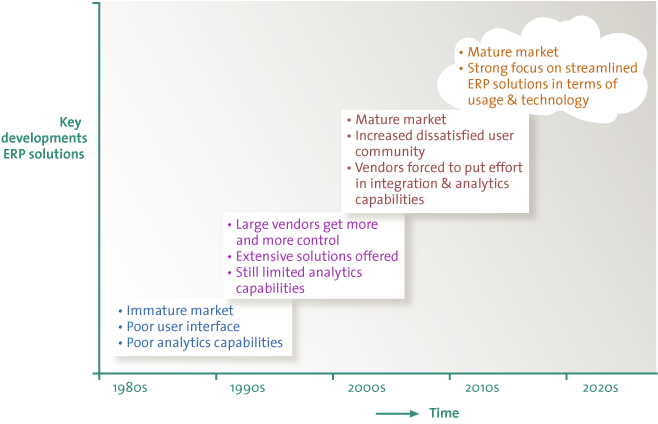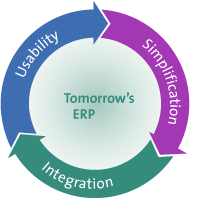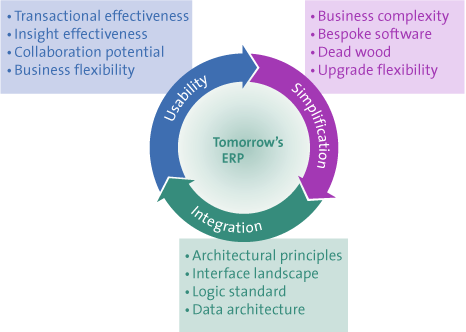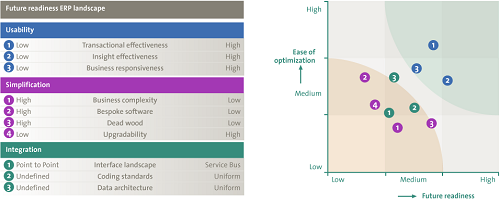For many years, organizations have pursued a fully integrated ERP solution. In practice this ambition has proven to be difficult to reach, and once the ERP solution is operational, organizations are having difficulty maintaining an ERP landscape at an acceptable cost level. In a market environment where both internal and external customers are hard to please and will only become even more demanding, the key considerations aiming to determine the future readiness of an organization’s ERP landscape should be on the agenda of the CIO.
Introduction
The European ERP market can be regarded as a mature market; most ERP vendors support a vast set of business processes and industry solutions enabled by a wide range of system functionalities. Market maturity is confirmed by the fact that in Europe the number of large ERP projects has fallen significantly. After years in which the realization of transformation was the predominant driver for ERP investments, the market has become mature enough to ensure that for the coming years the main driver will be renovation, i.e., technical upgrading or migrating to a more recent version of the ERP solution.
Given these market dynamics, ERP vendors are also reconsidering their market approach. CIOs can benefit from this when trying to find a long-term solution to secure their ERP landscape. In this article, various insights are provided that may be helpful in assessing the future readiness of an ERP landscape.
Key Developments ERP Solutions
“Traditional ERP needs to be renovated for the digital future” ([Gart14])
Most organizations have reached a stage where their ERP landscape can be regarded as relatively mature. However, the question remains whether this maturity also secures the long-term support of the organization’s ever-faster changing business needs. To achieve this, it is vital that CIOs closely monitor the major trends in the ERP market. Without this information, it will be very challenging to decide how to proceed.
About thirty years ago, the first ERP packages appeared, initially with a limited range of functionality. During the nineties, the focus was more on further integration and increasing the scope of business process support. Especially in the last 15 years, major suppliers such as Oracle and SAP invested significant amounts in their ERP solutions, not only for the purpose of continuous development, but also via numerous acquisitions. Eventually this resulted in ERP solutions that are able to cover a wide range of business requirements, including improved analytical capabilities.

Figure 1. Overview key developments ERP in period 1980 – 2020 (enriched model based on Gartner study ([Gart14]).
The downside of the expanding ERP suite in terms of process support and functionaly is a higher level of complexity resulting in an increased cost burden. Given the current economic climate, cost reduction is at the top of the CIO’s agenda. Transforming complex processes and bespoke software into standard (industry best practice) processes supported by out-of-the box IT solutions is the logical answer to rationalizing IT spend. This trend is accelerated by emerging cloud offerings from existing and new vendors. However, trends such as “cloud” make high demands on an organization’s ERP landscape, an issue that many organizations currently have problems dealing with. As the impact of “cloud” will further increase in the coming years, it is important that organizations determine the future readiness of their ERP landscape. In our view, key dimensions that can be helpful in this discussion are Usability, Simplification and Integration.

Figure 2. Key dimensions tomorrow’s ERP (source: KPMG).
Usability
“Although studies show that approximately 70% of the larger organizations are using an ERP solution, many organizations are struggling to unlock the full potential of their solution and obtain maximum business value from their IT assets”
For most ERP vendors usability has always been a weak spot, and even today they find themselves unable to deliver the level of usability that end-users expect and demand. Due to the every increasing pressure from the user communities, this topic can no longer be neglected. This has been recognized by the traditional vendors such as SAP, ORACLE and Microsoft, who are now focusing all their attention on this area and realizing significant improvements in the realm of usability.
This is a promising trend, which may definitely be helpful in determining the future readiness of an ERP landscape. However, a CIO’s research into the usability aspect should extend beyond the basic user friendliness of ERP solutions. To achieve this, it is essential to analyze this topic from three important angles:
- Transactional effectiveness. We consider this to be the basic usability of ERP solutions. Although improvements have been made, there is much to be gained by improving the interaction between the user and the system in terms of transaction processing. User transactions can already be simplified by applying usability design guidelines, for example with the support of tools such as SAP Fiori and Oracle Applications UX, and generally with simplified web-based interfaces. The downside of this simplicity ‘outside the box’ is that it is often based on standardized and harmonized business processes, from a vendor point of view. In case of highly customized or even bespoke functionality, the effects of simplified interfaces are drastically reduced. However, within the market interesting solutions are likewise available that can also provide benchmark data, and thereby insight into transactions allowing the system to be used more efficiently and effectively.
- Insight effectiveness. In the coming years significant investments will be necessary to meet the ongoing requirements of improved insight into the available ERP data. Despite the improved reporting solutions that most ERP providers are offering, many organizations are still having difficulties in translating their ERP data into useful managerial information. User communities expect and demand to get offered actionable dashboards and insights based on real-time ERP data. Collaboration potential: In today’s economic environment, but especially in that of tomorrow the collaboration between market parties (e.g., customers and suppliers) will further increase. The consequence of this is that the usability of the business processes and their reflection in the supporting ERP solutions will become more and more important as they define the successful integration between an organization and its chain partners.
- Business responsiveness. Being a combination of the aspects mentioned above, the business flexibility of an organization is impacted by the ERP and process usability. If an organization has a highly complex business model and is faced with the necessity to alter processes, markets, distribution channels or any other significant form of business heuristics, it is obvious that it will be difficult to realize such changes. The usability of the ERP solution hinges on this as the integration with chain partners, shift in key performance indicators and user training need to be aligned accordingly. The goal should be to keep one’s business complicated (if required) where no changes are expected and simple where an organization needs to be flexible.
When performing an analysis focusing on the dimensions above, organizations will be able to gain a good insight into the “Usability”, both from IT and business perspectives. As mentioned above, “Usability” is one of the key dimensions to determine the future readiness of an ERP landscape. In the next paragraph the dimension “Simplification” will be discussed in more detail.
Simplification
“Often business complexity drives ERP complexity. Changing the mindset of business owners that many of their processes are not differentiating and should therefore follow standard industry best practices, is the first, biggest and most difficult step towards ERP simplicity”
Driven by a focus on cost reduction and business responsiveness as enabled by cloud technology, ERP providers are going out of their way to simplify their ERP solutions. SAP is strongly positioning its SAP4 HANA solution as an easier one from a user experience, business solution and data model perspective. Oracle, too, is positioning its Fusion ERP concept as a streamlined solution incorporating the best of its practices. When playing “the devil’s advocate” one could argue that by offering these solutions the providers admit that ERP solutions have become too complex.
Organizations themselves have played an major role in creating a complex ERP landscape. Too often, organizations have not been able to adopt long-term guiding principles that they initially agreed on, such as “homogenous landscape”, “standard functionalities first”. Therefore CIOs should definitely examine to what extent they can simplify their ERP landscape without losing sight of the key business requirements.
To realize a simplicification of the ERP landscape, it is important to identify the factors that determine simplicification. Like the previous dimension (Usability) this dimension too is impacted from a business as well as an IT side.
- Business complexity. This factor is the most complex to handle. Many ERP landscapes have become over-sophisticated because a lot of effort (and money) has been put in making sure that the solution would reflect the business in a correct way. In consequence, many organizations have moved away from the standard functionalities and harmonized processes within their initial ERP landscape (instead of ‘adopt’, the ‘adapt’ principle has prevailed). The downside is that this is not maintainable in the long term; businesses need to simplify their processes and ERP solution to be ready for the future at all times. To achieve this it is important that ambassadors of the ERP solution are available in the business (e.g., information managers). In addition, the presence of a strong community of process owners with not just a thorough understanding of the business, but also of IT, is a critical success factor. These stakeholders should play a key role in the periodical review of the organization’s compliance to original guidelines and standardized processes.
- Bespoke software. Closely related to the previous point is the number of extensions of the ERP solution. With terms such as CEMLI and RICEFWs,[CEMLI is the accepted abbreviation in the context of Oracle ERP solutions and stands for Configuration, Extension, Modification, Localization and Integration. RICEFW is a term used within the SAP-world and stands for Reports, Interfaces, Conversion, Extensions, Forms and Workflow.] the number of custom developments within ERP solutions are identified. In short, these extensions all imply additional programs and procedures on top of the basic standard functionalities. Virtually every organization is making use of these extensions. However, within some organizations the amount of extensions has grown to such an extent that the maintenance of the ERP solution has become a disproportionate burden. It is interesting to note that in many cases extensions have become redundant, which means that the business community is not using them anymore. Within the market there are many interesting solutions that could help in the analysis of the extensions within the ERP solution, and a cleanup will definitely facilitate upgrade efforts as well as regression testing activities.
- Dead wood. By dead wood we mean redundant data within ERP landscapes. “Dead wood” is just two words, but they have become more and more important over the years. The reason is that ERP applications are increasingly suffering under redundant data, both from a transactional and master data point of view. In order to keep this manageable, it is important that clear archiving strategies are implemented, instead of the easy way out of “Buying and activating additional hardware.”
- Upgradability. Market experience has shown that even today many IT organizations are having trouble making sure that their ERP organizations are running on a recent version. The main challenges are the associated costs and risk management. The implementation of large upgrades in particular can entail significant costs (not only in case of a migration, but also in case of a technical upgrade), as both require a significant amount of testing effort. Closely related to this is risk management: if a new version does not result in concrete added value, organizations will be reluctant to make changes in their current ERP landscape, as this could endanger their running business.
Both “Usability” and “Simplification” have integration aspects. As the importance of Integration/Interfaces with other systems (both internal and external) will further grow in the coming years, the next paragraph will deal with this topic in some more detail.
Integration
“Integration complexity increases, but vendors hide this in the clouds” ([Gart14])
Various studies support the view that the integration concept will be a key determining factor within the ERP solution. For example, when ERP solutions are brought back to their core (which means leaner applications), the focus on integration will increase to ensure a close harmony with surrounding applications and processes (e.g., via service bus concepts). This focus on further integration can be considered one of the most challenging developments. Also in the future, some components of the ERP solutions will behave like “transaction factories”, meaning the processing of a large number of transactions in an efficient and effective manner. To support the “transaction factories’, other parts of the ERP solution need to ensure a smooth integration with the outside world. If this is not accomplished in a standard way, organizations will once again be confronted with complex and costly ERP landscapes. It is important to note that interfaces are a given; even if organizations have succeeded in implementing the most extensive ERP landscape, interfaces are still called for. However, the quality and consistency of the interfaces need to be ensured and in this area there is room for improvement within many organizations. It is vital that IT organization test the quality of their interfaces in great detail and for this purpose the following factors need to be taken into account:
- Interface landscape. At present most IT departments need to maintain a large number of interfaces, most of which are still point-to-point solutions (both inbound and outbound). It is obvious that this may well result in a complex ERP landscape, reducing the flexibility to change and thereby entailing additional costs. To counteract this, the development of a service bus is a good alternative. It is interesting to see that ERP providers are just as much anticipating this development and in fact opening their ERP package to facilitate the connectivity with other applications.
- Coding standards. Applying standards when designing and building an interface sounds obvious, but existing interfaces may well have been designed and built differently, resulting in different ways of data verification and reconciliation. Likewise, the way of error handling and archiving are often subject to improvement. The consequence is that the maintenance of the interfaces remains time-consuming and costly. In addition, the lack of supporting functional and technical documentation is an impediment to improvement in this area.
- Data architecture. A key factor to determine the quality of the interface landscape, is the way in which the data architecture has been defined. An essential driver for data architecture is of course master data management (hereafter MDM), which has the aim to secure one data source per data object. In our view MDM is a crucial concept when it comes to determining and improving the quality of the data being used within the organisation and thereby to decide which data can actually be regarded as information.
It is important to note that for the above factors architectural principles will be defined which reflect a level of consensus during the complete lifecycle of software. Regrettably, many organizations still have not defined these principles or have not put defined principles into practice, resulting in software that is not developed and maintained in a consistent way and thereby endangering the long term of an ERP solution.
Comment in Conclusion
After decades in which ERP solutions have become broader and broader in their coverage of functionality, it is expected that in the coming years the focus will be more on improving the ERP solution in terms of usage and supporting IT. The consequence is that the focus of the CIO should move towards creating an ERP landscape that will meet requirements in terms of increased usability, simplification and integration. Various factors impact the success of optimizing each of these trends, and as is the case with many aspects of ERP solutions, this is not just an IT discussion; after all, many aspects are related to the business. In this context, a close cooperation with the business community is essential.

Figure 3. Overview characteristics key developments tomorrow’s ERP (source: KPMG).
To determine the future readiness of each aspect, it is useful to perform an exercise where the maturity of each different characteristic is plotted into a heatmap. This will allow the CIO to facilitate the dialogue with the business and focus on the areas which require his prime attention. In the attached example the outcome of an assessment for each factor is reflected in a heatmap with the dimension “Ease of optimization” versus “Future readiness”. The example shows that the factors “Simplification” and “Integration” in particular score relatively low and are therefore more likely to require greater effort to make the ERP landscape ready for the future.
Figure 4. Example of heatmap for key developments tomorrow’s ERP (source: KPMG). [Click on the image for a larger image]
The results of such an analysis can be helpful in starting the discussion with the business community, because without their close involvement it will be very difficult to realize benefits in terms of reducing costs, faster responsiveness to every changing market demands and last but not least increased user satisfaction.
References
[Comp15] Computer Profile, Analytic Paper, March 2015.
[Eila13] S. Eilander and T. Willebrands, ERP in the cloud, Compact 2013/3.
[Gart14] Gartner, Postmodern ERP: A Vital Foundation for Digital Business, 2014.
[Inte12] Intelligent Licensing, Enterprise Resource Planning Systems in 2020, 2012.






